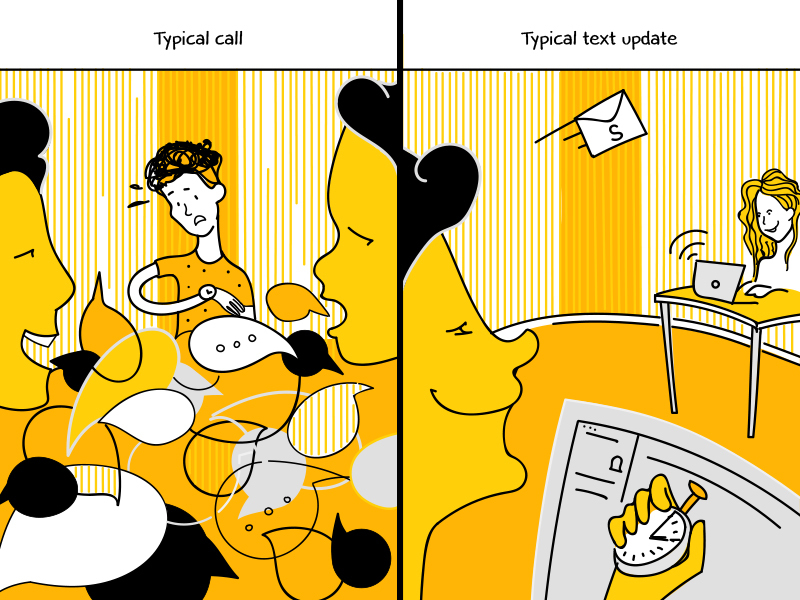- What we do
- Services
- Solutions
- Our Works
- Company
- Contact Us
Managing time differences is a natural part of our life at Yellow. Many of our partners are located in the US, particularly California, and the time difference between Minsk and San Francisco is ten hours. At first glance, it might look like a hurdle to a healthy business relationship, but is that really the case?
In fact, we have built our own solution to time differences, which in most cases helps us and our clients completely forget that time zones even exist. In this article, we share some of our rules and life hacks for how to overcome the obstacle of time differences. Here we go!
Rule #1: If you think that time difference is the reason your workflow goes off the rails, be sure it's not
Teams tend to blame time differences when a project doesn't make adequate progress, saying that it’s because they cannot immediately hold a meeting to discuss all of the issues that have arisen. In fact, such a statement is a definite sign that something in the workflow is not right!
In a healthy environment, it’s not necessary to keep in touch 24/7, especially when you are in different time zones. Every day, everyone is busy with their tasks according to well-planned schedules, and there is no need for urgent meetings. No room for drama!
For an average project with a time difference issue, it’s okay to get away with a maximum of six meetings per two-week sprint. A recommended meeting schedule includes:
- a planning meeting before a sprint starts
- a retrospective meeting at the end of the sprint
- one additional meeting a week later to update a project backlog
There can also be occasional meetings between a client and a project manager, which are held by necessity and don’t involve the entire team.
We never ignore planning meetings. If held properly, a what-should-I-do-today question will never arise among team members. The rest of the meetings are perfectly adequate to keep the project viable and resolve the issues that sometimes unexpectedly arise even if the sprint is well-planned.
That’s it. No magic, just pure planning. However, without proper planning, any project turns into a mess, and then everyone blames the time difference instead of blaming a lack of discipline.

Rule #2: Adjust, not get adjusted
Daily standups are an essential part of any software engineering team’s day-to-day routine. The perfect standups are short and to the point, serving as a daily update on everyone's progress.
However, many teams fall into a trap when standups last too long, turning from a productive 15-minute discussion into a detailed review of the working day that takes place, on top of that, at the end of the very same working day.
When we just started working with US clients and were met with time differences for the first time, we used to hold daily standups via Skype, usually late in the evening. All of them quite literally resembled a ground-hog day: Either someone pretends to be a TED speaker or two people discuss a specific problem, while everybody else yawns and waits for the meeting to finish.
It didn’t take us long to understand that those daily standups don’t have to be like that, and we decided to change their format. Now, at the end of each working day, every team member receives a reminder in Slack to send a daily text report to the client, opens a channel created for this purpose, types a few phrases — and voila! No more midnight meetings and adjusting to time zones! Daily standups now take 15 seconds instead of one-two hours.
Moreover, all reports are stored in the channel history and can be accessed anytime, so say goodbye to lame excuses such as “I forgot to do this,” or “I didn’t know I should do that.” Profit from accountability!

Rule #3: Start late, leave late
Though the time difference is a factor that can’t be completely ignored, its impact can still be lowered with the help of some simple workarounds. We at Yellow have devised the most elegant solution on how to do this which costs us nothing.
We simply shifted our working day to start at later hours. Now, instead of starting at 8 AM, we start at 12 PM, so the actual time difference between us and our US partners is reduced by four hours, making it a lot more manageable. As a bonus, we feel much more comfortable during late meetings knowing that we don’t have to be in the office by 8 AM the next day.

Now, what if something urgent happens?
No matter how smooth a project runs, an unexpected issue may catch you with your pants down. For example, we had a situation when we received a call from our Californian client at 3 AM Belarus time. They were preparing a marketing event with our product when the server suddenly went down.
Despite the non-working hours, we fixed the problem. Be sure, if a similar situation ever happens in the future, we will be ready to tackle it at any time.
If you've got any questions, we're here for you
Your friends at YellowFinal words
There are only two options: either you manage the time difference, or it manages you. But the good news is that it’s completely up to you to choose which side you are on. So make the right choice!
✔Read also:
How to Create a Chat App like WhatsApp: The Extensive Guide
RESTful API guidelines to Follow
Got a project in mind?
Fill in this form or send us an e-mail
Subscribe to new posts.
Get weekly updates on the newest design stories, case studies and tips right in your mailbox.
